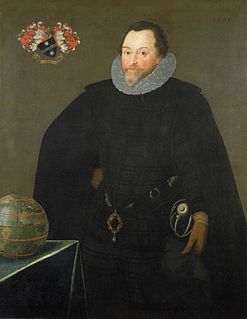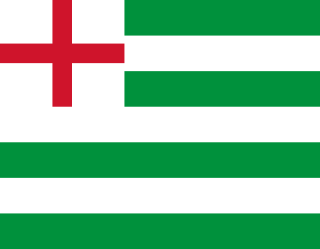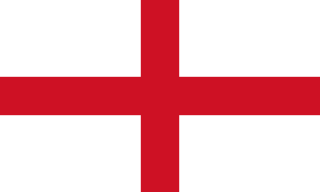Related Research Articles

Sir Francis Drake was an English explorer, sea captain, privateer, slave trader, naval officer, and politician. Drake is best known for his circumnavigation of the world in a single expedition, from 1577 to 1580. This included his incursion into the Pacific Ocean, until then an area of exclusive Spanish interest, and his claim to New Albion for England, an area in what is now the U.S. state of California. His expedition inaugurated an era of conflict with the Spanish on the western coast of the Americas, an area that had previously been largely unexplored by Western shipping.

Sir John Hawkins was a pioneering English naval commander and administrator. He was also a privateer and an early promoter of English involvement in the Atlantic slave trade.

The Anglo-Spanish War (1585–1604) was an intermittent conflict between the Habsburg Kingdom of Spain and the Kingdom of England. It was never formally declared. The war included much English privateering against Spanish ships, and several widely separated battles. It began with England's military expedition in 1585 to what was then the Spanish Netherlands under the command of the Earl of Leicester, in support of the Dutch rebellion against Spanish Habsburg rule.

The Tudor navy was the navy of the Kingdom of England under the ruling Tudor dynasty (1485–1603). The period involved important and critical changes that led to the establishment of a permanent navy and laid the foundations for the future Royal Navy.

Robert Adams (1540–1595) was a 16th-century English architect, engraver and surveyor of buildings to Queen Elizabeth. He was a son of Clement Adams.
Vice-Admiral Lord Henry Seymour (1540–1588) was an English naval commander and Admiral of the Narrow Seas during the Elizabethan Age.

The Spanish Armada was a Spanish fleet of 130 ships that sailed from Lisbon in late May 1588 under the command of the Duke of Medina Sidonia, with the purpose of escorting an army from Flanders to invade England. Medina Sidonia was an aristocrat without naval command experience but was made commander by King Philip II. The aim was to overthrow Queen Elizabeth I and her establishment of Protestantism in England, to stop English interference in the Spanish Netherlands, and to stop the harm caused by English and Dutch privateering ships that disrupted Spanish interests in the Americas.

Richard Drake of Esher, was Equerry of the Stable and Groom of the Privy Chamber to Queen Elizabeth I. He also held office as a Member of Parliament and Justice of the Peace.

The Raid on Mounts Bay also known as the Spanish attack on Mounts Bay was a Spanish raid on Cornwall, England, that took place between 2 and 4 August 1595 during the Anglo-Spanish war of 1585-1604. It was conducted by a Spanish naval squadron led by Carlos de Amésquita on patrol from Brittany, France. The Spanish made landfall in Mount's Bay then sacked and burned Newlyn, Mousehole, Penzance, and Paul, beating a militia force under Francis Godolphin in the process.

The siege of Fort Crozon or the siege of El Leon was a land and sea engagement that took place late in the French wars of religion and the Anglo-Spanish War (1585–1604). The siege was fought between 1 October and 19 November 1594 and was conducted by English and French troops against a Spanish fort constructed on the Crozon Peninsula near Brest. After a number of assaults were repelled, a Spanish relief force under Juan del Águila attempted to relieve the garrison, but it was delayed by French cavalry and could not reach the garrison in time.

The Sea Dogs were a group of English privateers authorised by Queen Elizabeth I to raid England's enemies, whether they were formally at with war with them or not. Active from 1560 onwards until Elizabeth's death in 1605, the Sea Dogs primarily attacked Spanish targets, both on land and on sea, particularly during the Anglo-Spanish War. Members of the Sea Dogs, including Sir John Hawkins and Sir Francis Drake, also engaged in illicit slave trading with Spanish colonies in the Americas.

The Battle of Berlengas Islands was a naval battle which took place off the Portuguese coast on 15 July 1591, during the war between Elizabeth I of England and Philip II of Spain. It was fought between an English privateer squadron under George Clifford, 3rd Earl of Cumberland, who had set out his fortunes by large-scale privateering, and a squadron of 5 Spanish galleys commanded by Francisco Coloma tasked with patrolling the Portuguese coast against privateers. While anchored off the Berlengas, the English ships were surprised by the Spanish galleys, which succeeded in taking one English ship and rescuing two prizes.

The siege of Amiens was a siege and battle fought during the Franco-Spanish War (1595-1598), as part of both the French Wars of Religion and the Anglo-Spanish War (1585–1604), between 13 May and 25 September 1597. The Spanish, who had sent a large army in March, had captured the city of Amiens easily in a ruse. Henry IV of France, after the surprise of the capture, immediately and quickly built up an army which included a large English force and besieged Amiens on 13 May.
The Siege of Le Catelet, also known as the Capture of Le Catelet, took place at the stronghold of Le Catelet, in Picardy, between 20 and 26 June 1595, as part of the Franco-Spanish War (1595-1598) in the context of the French Wars of Religion. After a short siege, the Spanish forces commanded by the new Governor-General of the Spanish Netherlands, Don Pedro Henríquez de Acevedo, Count of Fuentes (Spanish: Conde de Fuentes), took the French fortress, compelling its garrison to surrender, as part of his offensive of 1595. A few days later the Count of Fuentes and his forces continued with the offensive and took La Capelle. On 14 July they arrived at Doullens and laid siege to the city.

The 2nd Spanish Armada also known as the Spanish Armada of 1596 was a naval operation that took place during the Anglo–Spanish War. Another invasion of England or Ireland was attempted in the autumn of 1596 by King Philip II of Spain. In an attempt at revenge for the English sack of Cadiz in 1596, Philip immediately ordered a counter strike in the hope of assisting the Irish rebels in rebellion against the English crown. The strategy was to open a new front in the war, forcing English troops away from France and the Netherlands, where they were also fighting.

The 3rd Spanish Armada, also known as the Spanish Armada of 1597, was a major naval event that took place between October and November 1597 as part of the Anglo–Spanish War. The armada, which was the third attempt by Spain to invade or raid the British Isles during the war, was ordered by King Philip II of Spain in revenge for the English attack on Cadiz following the failure of the 2nd Spanish Armada the previous year due to a storm. The Armada was executed by the Adelantado, Martín de Padilla, who was hoping to intercept and destroy the English fleet under Robert Devereux the 2nd Earl of Essex as it returned from the failed Azores expedition. When this was achieved, the Armada would go on to capture either the important port of Falmouth or Milford Haven and use those places as a base for invasion.
Sir Robert Southwell (1563–1598), of Woodrising, Norfolk, was an English politician.

The Admiral of the Narrow Seas also known as the Admiral for the guard of the Narrow Seas was a senior Royal Navy appointment. The post holder was chiefly responsible for the command of the English navy's Narrow Seas Squadron also known as the Eastern Squadron that operated in the two seas which lay between England and Kingdom of France and England and the Spanish Netherlands later the Dutch Republic from 1412 to 1688. His subordinate units, establishments, and staff were sometimes informally known as the Command of the Narrow Seas.

The Armada Tapestries were a series of ten tapestries that commemorated the defeat of the Spanish Armada. They were commissioned in 1591 by the Lord High Admiral, Howard of Effingham, who had commanded the Royal Navy against the Armada. In 1651 they were hung in the old House of Lords chambers, which at the time was used for the meetings of the committee of Parliament. They remained there until destroyed in the Burning of Parliament of 1834.

The Channel Squadron also referred to as the Western Squadron (1512-1649) was a series of temporary naval formations first formed in under the English Tudor Navy Royal during the sixteenth century. Later during the Interregnum a channel squadron was formed as part of the Commonwealth Navy. During the 18th century as part of the Royal Navy.
References
- ↑ George Steinman Steinman, A History of Croydon, Longman, Rees, Orme, Brown, Green & Longman, 1834, p.127
- ↑ Robert Edmond Chester Waters, Parish Registers in England: Their History and Contents, with Suggestions for Securing Their Better Custody and Preservation, F.J. Roberts, 1883, p.45
- 1 2 3 4 Charles Henry Cooper, Athenae Cantabrigienses: 1586-1609, Deighton, Bell, 1861, p.202